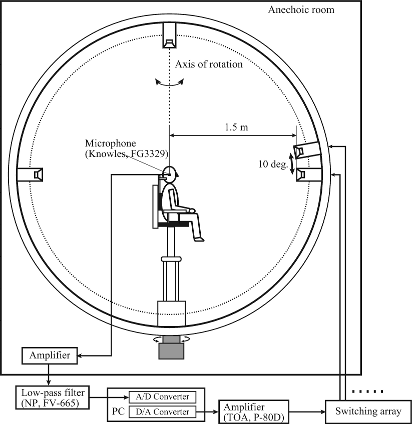Outline of measurement
HRTF
A set of HRTFs for each subject was measured according to the definition described in [1]. All transfer functions were obtained by measuring the impulse responses. The optimized Aoshima’s time-stretched pulse (OATSP) [2] was used as the source signal to measure the impulse responses. Figure 1 shows the HRTF measurement system. The measurement was conducted in the anechoic room of the Research Institute of Electrical Communication, Tohoku University. The loudspeakers were arranged at intervals of 10 degrees of the elevation angle excluding the angle directly below the subject. The circular loudspeaker array could be automatically rotated around the vertical axis with a resolution of 0.1 degrees.Please refer to the following articles for more information.

Fig.1: Measurement system
Anthropometry
Three-dimensional images of subjects above and including their shoulders were measured for 39 subjects whose HRTFs were measured. A three-dimensional scanner (VIVID910, Konica Minolta) was used for this measurement. All measured anthropometric dimensions are included in this dataset, in the data format of stereolithography (STL).Reference
- [1] J.Blauert, Spatial Hearing (The MIT Press, Cambridge, MA, 1983).
- [2] Suzuki, F. Asano, H. Y. Kim and T. Sone, “An optimum computer-generated pulse signal suitable for the measurement of very long impulse responses,” J. Acoust. Soc. Am., 97, 1119–1123 (1995).